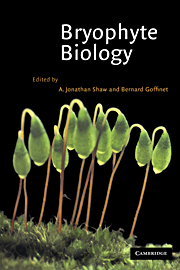Book contents
- Frontmatter
- Contents
- List of contributors
- Preface
- 1 Anatomy, development, and classification of hornworts
- 2 Morphology and classification of the Marchantiophyta
- 3 Morphology and classification of mosses
- 4 Origin and phylogenetic relationships of bryophytes
- 5 Chemical constituents and biochemistry
- 6 Molecular genetic studies of moss species
- 7 Control of morphogenesis in bryophytes
- 8 Physiological ecology
- 9 Mineral nutrition, substratum ecology, and pollution
- 10 Peatlands: ecosystems dominated by bryophytes
- 11 Role of bryophyte-dominated ecosystems in the global carbon budget
- 12 Population ecology, population genetics, and microevolution
- 13 Bryogeography and conservation of bryophytes
- Index
10 - Peatlands: ecosystems dominated by bryophytes
Published online by Cambridge University Press: 05 June 2012
- Frontmatter
- Contents
- List of contributors
- Preface
- 1 Anatomy, development, and classification of hornworts
- 2 Morphology and classification of the Marchantiophyta
- 3 Morphology and classification of mosses
- 4 Origin and phylogenetic relationships of bryophytes
- 5 Chemical constituents and biochemistry
- 6 Molecular genetic studies of moss species
- 7 Control of morphogenesis in bryophytes
- 8 Physiological ecology
- 9 Mineral nutrition, substratum ecology, and pollution
- 10 Peatlands: ecosystems dominated by bryophytes
- 11 Role of bryophyte-dominated ecosystems in the global carbon budget
- 12 Population ecology, population genetics, and microevolution
- 13 Bryogeography and conservation of bryophytes
- Index
Summary
Introduction
Peatlands are unbalanced ecosystems where plant production exceeds decomposition of organic material. As a result, organic material, or peat, accumulates. This organic material is composed primarily of plant fragments remaining after partial decomposition of the plants that at one time lived on the surface of the peatland. Decomposition occurs through the action of microorganisms that have the ability to utilize dead plant components as sources of carbon for respiration (Thormann & Bayley 1997) in both the aerobic acrotelm and the anaerobic catotelm (Clymo 1984, Wieder et al. 1990, Kuhry & Vitt 1996). Labile cell contents, cellulose, and hemicellulose are more readily available sources of carbon than recalcitrant fractions that contain lignin-like compounds, with these latter compounds being concentrated in peat by decomposition (Turetsky et al. 2000). Vascular-plant-dominated, tree, shrub, and herb layers produce less biomass (Campbell et al. 2000) and decompose more readily than the bryophyte-dominated ground layer (Moore 1989). Surfaces of northern peatlands are almost always completely covered by a continuous mat of moss (National Wetlands Working Group 1988, Vitt 1990), and the large amount of biomass contained in this layer is composed of cell-wall material that decomposes slowly. This slow decomposition coupled with saturated, anaerobic conditions, cool climate, and/or short growing season allows organic matter to accumulate over large areas. Thus, most peat from northern peatlands is largely composed of a high percentage of material derived from bryophytes.
- Type
- Chapter
- Information
- Bryophyte Biology , pp. 312 - 343Publisher: Cambridge University PressPrint publication year: 2000
- 62
- Cited by



